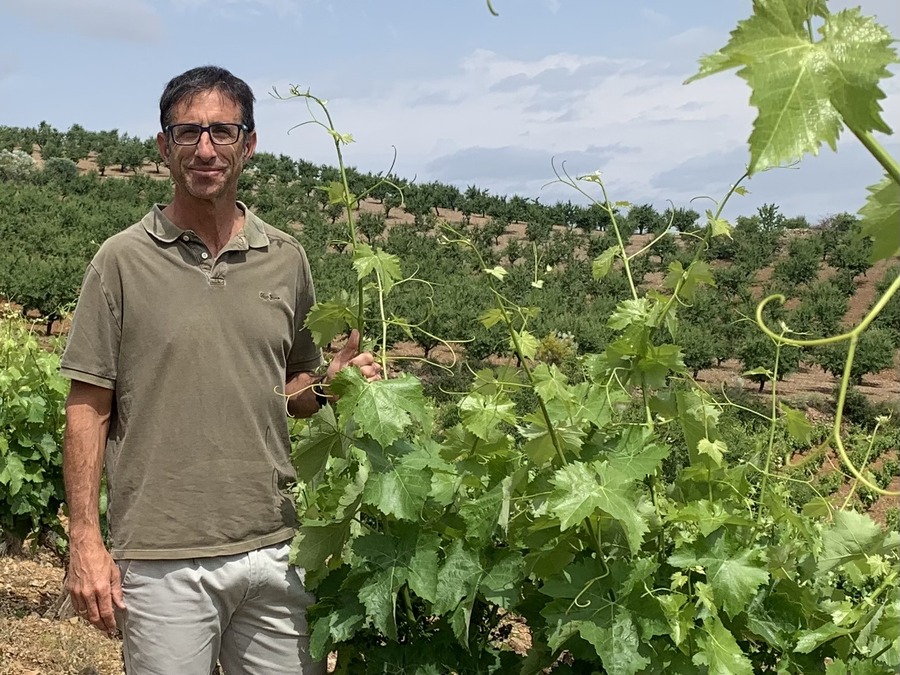
Jorge Navascués, a third-generation winemaker based in Aragón, is one the leading figures championing Garnacha in Spain. His grandfather worked as a cellarman at the San Juan cooperative in Fuendejalón, now Bodegas Aragonesas. His father, Jesús Navascués, aged 75, retired in 2024 after a long career consulting for numerous wineries across Aragon, including Somontano, as well as Navarra and Tenerife. Jorge began working alongside him in 1997 but has since scaled back his consultancy services, focusing now on just two clients: Viña Zorzal in Navarra and the CVNE group, where he is technical director at Contino in Rioja and Virgen de Galir in Valdeorras (Galicia).
In the early 2000s, the Navascués family decided to go beyond their work as consultants and create their own wine. They partnered with Carlos San Pedro, founder and owner of Bodegas y Viñedos Pujanza in Laguardia (Rioja Alavesa), to launch a project under the name Mancuso, a reference to a coin issued in Aragon in the early 11th century. Their aim was to showcase the distinctive qualities of the old Garnacha vines in Jarque del Moncayo (Zaragoza). The collaboration lasted until 2011, but in 2015 Jorge and his father revived the Mancuso brand, keeping its focus on Garnacha but seeking a new vineyard to source grapes.
The eventually settled in Almonacid de la Sierra (Zaragoza), a village they knew well in terms of vine growing where they had strong local ties. Almonacid sits in the foothills of the Sierra de Algairén, around 10 kilometres from Cariñena. The area's rugged terrain contrasts sharply with the valley floor, where much of the DO Cariñena’s vineyard area is concentrated.
Initially, they rented a winery and bought in grapes. Gradually, they began acquiring some old vineyards and planting new vines at the same pace. They currently own 4.5 ha.
They have their own facilities since 2025 thanks to the refurbishment of one of the old bodegas in the village, complete with underground cellars. Only premium wines are produced here, while the entry-level wines sold under the brand Cutio continue to be made at the rented premises.
Concrete is used for both fermentation and ageing. Oak is limited to large-sized barrels and foudres will be gradually introduced.
The wines
The white Cutio (€9, 20,000 bottles) is an excellent value Macabeo aged in concrete tanks that offers an unusual texture and length for the price. With hardly any oak influence, the red version (€9, 80,000 bottles) includes 10% Cariñena in the blend adding a touch of rusticity as well as liveliness.
Mancuso (€14, 15,000 bottles) is the most widely available wine within the premium range. Grapes are sourced from various plots located in the mid and upper areas of the village. Partially fermented with stems, the wine sees more influence from concrete than from wood during ageing . It is a pure, expressive Garnacha dominated by mountain undergrowth and liqueur red fruit.
The Mas de Mancuso range are single-vineyard wines made from owned plots with a northern exposure. It comprises two reds, one Garnacha and one Cariñena, as well as a white Macabeo. Production ranges from 3,000 to 1,200 bottles, with retail prices in Spain kept below €30. The red Garnacha is sourced from an isolated plot of just under one hectare surrounded by almond trees and it is the last to be picked. This is the winery's freshest red, as well as the most delicate, yet with depth and the potential to age. Sourced from slate soils, the Cariñena is consistent and fresh, while the white Macabeo, also grown on slate, is a well-balanced, serious wine with a distinctive Mediterranean profile.
Most popular
NEWSLETTER
Join our community of Spanish wine lovers


